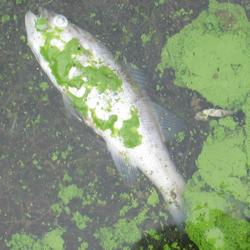New Guide to Help Identify Harmful Algal Blooms Completed
Close up of the cyanobacteria Dolichospermum lemmermannii
Microscopic photograph of the cyanobacteria Dolichospermum circinale
To assist Native American and Alaska Native communities, U.S. Geological Survey (USGS) scientists developed a guide to evaluate algal blooms for the presence of cyanobacteria that are known to produce a variety of toxins.

Because many Native American and Alaska Native communities are dependent on subsistence fishing, they may have an increased risk of exposure to toxins from harmful algal blooms. To help address this risk, USGS scientists developed a field and laboratory guide for identification of cyanobacteria that are capable of producing toxins. The toxins are commonly referred to as cyanotoxins and can negatively affect fish, wildlife, and people.
The guide provides images of cyanobacteria blooms in field settings, non-toxic algal blooms, and floating aquatic vegetation. The images can help public health officials and water-resource managers recognize potential toxin-producing cyanobacterial blooms in the field. To help with more specific identification, the guide provides microscopic images of common cyanobacteria that are known to produce toxins.
Exposure to cyanotoxins can cause a range of effects from simple skin rashes to liver and nerve damage in humans, companion animals, livestock, and wildlife. The guide facilitates the important first step of recognizing the presence of potentially harmful algal blooms.
This research was funded by the USGS Ecosystems Mission Area’s Environmental Health Program (Contaminant Biology and Toxic Substances Hydrology) and the USGS Office of Tribal Relations provided Tribal Science Coordination funds for the development of the guide.

Below are other science projects associated with this project.
Toxins and Harmful Algal Blooms Science Team
Understanding Drivers of Cyanotoxin Production in the Lake Okeechobee Waterway
Below are publications associated with this project.
Field and laboratory guide to freshwater cyanobacteria harmful algal blooms for Native American and Alaska Native communities
To assist Native American and Alaska Native communities, U.S. Geological Survey (USGS) scientists developed a guide to evaluate algal blooms for the presence of cyanobacteria that are known to produce a variety of toxins.

Because many Native American and Alaska Native communities are dependent on subsistence fishing, they may have an increased risk of exposure to toxins from harmful algal blooms. To help address this risk, USGS scientists developed a field and laboratory guide for identification of cyanobacteria that are capable of producing toxins. The toxins are commonly referred to as cyanotoxins and can negatively affect fish, wildlife, and people.
The guide provides images of cyanobacteria blooms in field settings, non-toxic algal blooms, and floating aquatic vegetation. The images can help public health officials and water-resource managers recognize potential toxin-producing cyanobacterial blooms in the field. To help with more specific identification, the guide provides microscopic images of common cyanobacteria that are known to produce toxins.
Exposure to cyanotoxins can cause a range of effects from simple skin rashes to liver and nerve damage in humans, companion animals, livestock, and wildlife. The guide facilitates the important first step of recognizing the presence of potentially harmful algal blooms.
This research was funded by the USGS Ecosystems Mission Area’s Environmental Health Program (Contaminant Biology and Toxic Substances Hydrology) and the USGS Office of Tribal Relations provided Tribal Science Coordination funds for the development of the guide.

Below are other science projects associated with this project.
Toxins and Harmful Algal Blooms Science Team
Understanding Drivers of Cyanotoxin Production in the Lake Okeechobee Waterway
Below are publications associated with this project.



